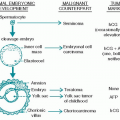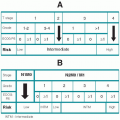Metastases of Unknown Origin
Dennis A. Casciato
The definition of metastases of unknown origin (MUOs). MUOs are metastatic solid tumors (hematopoietic malignancies and lymphomas are excluded) for which the site of origin is not suggested by thorough history, physical examination, chest radiograph, routine blood and urine studies, and thorough histologic evaluation.
The predicament of MUO. The detection of MUO usually represents the discovery of a far-advanced malignancy that is rarely curable and that is usually refractory even to palliative chemotherapy. Tumors that are potentially responsive to systemic treatment are found in only about 20% of all patients with MUO. The diagnostic evaluations inflicted on these patients in pursuit of the primary site are typically excessive and futile. The primary site is found in <15% of cases, and that discovery rarely affects the prognosis or treatment. All efforts to manage patients who meet the criteria defined above should be guided by the understanding that there are two basic categories of MUOs: (1) those that are treatable and (2) those that are not.
I. EPIDEMIOLOGY AND BIOLOGY
A. Incidence. About 6% of patients with cancer present with MUO. MUO is the seventh most frequent malignancy, ranking below only cancers of the lung, prostate, breast, cervix, colon, and stomach. About 75% of tumors in the MUO syndrome originate below the diaphragm.
B. Age. The average age at onset is 58 years. Patients who present with a midline distribution of poorly differentiated carcinoma (10% of all MUO patients) have a median age of 39 years.
C. Manifestations. Symptoms of metastasis, which are present in nearly all patients with MUO syndrome, are multiple in 30% of patients. The most frequent presenting features are the following:
1. Pain (60%)
2. Liver mass or other abdominal manifestations (40%)
3. Lymphadenopathy (20%)
4. Bone pain or pathologic fracture (15%)
5. Respiratory symptoms (15%)
6. Central nervous system abnormalities (5%)
7. Weight loss (5%)
8. Skin nodules (2%)
D. Aberrant natural history of tumors in the MUO syndrome compromises the ability to predict the primary site of disease. Patterns of dissemination by tumors often do not follow typical pathways in the MUO syndrome. Examples are shown in Table 20.1. This observation represents the distinct biology of these malignancies wherein the metastatic behavior predominates unpredictably, while the primary tumor remains occult.
E. Mechanisms that could explain the presence of occult primary neoplasms include the following:
1. Excision or electrocautery may have removed unrecognized primary lesions years before the appearance of metastatic lesions.
2. The primary cancer may have shed metastases and then undergone spontaneous regression.
Table 20.1 Patterns of Dissemination by Tumors | ||||||||||||||||||||||||
|---|---|---|---|---|---|---|---|---|---|---|---|---|---|---|---|---|---|---|---|---|---|---|---|---|
| ||||||||||||||||||||||||
3. The primary tumor may be too small to be detected, even at autopsy.
4. The site of origin may be obscured by the extensiveness of metastases or by the atypical pattern of dissemination.
II. DIAGNOSIS AND HISTOPATHOLOGY
A. Performing a biopsy should be the first order of business. The pathologist should be informed before the biopsy that the primary site is not evident so that special studies can be planned.
1. Patients with metastases to neck lymph nodes only. Suspicious cervical nodes should not undergo excisional biopsy until a complete diagnostic evaluation of the head and neck has been performed (see Chapter 7, Section X). About 35% of these patients have potentially curable cancers of the upper aerodigestive tract. This is not the case for patients with supraclavicular lymph nodes, which may be directly excised for histologic examination.
2. Other patients who have suspected metastatic cancer. Biopsy of the most accessible site should be performed before specialized blood or radiologic studies are done; the histologic findings provide an invaluable guide for a rational diagnostic workup. Biopsy proof of metastatic cancer is necessary at only one site. If several areas of tumor involvement are suggested by the findings from the screening evaluation, the preferred biopsy site is that associated with the least morbidity (e.g., peripheral lymph nodes when palpable, bone marrow when a leukoerythroblastic blood picture is present, cytology of sampled effusions, or suspect skin lesions). The biopsy specimen should be placed in a fixative that allows immunoperoxidase analysis.
B. Role of the pathologist Close communication between the clinician and the pathologist is especially important in cases of MUO. Morphologic clues may make certain anatomic sites more likely and direct the sequence of investigation.
1. Histologic problems
a. Poorly differentiated tumors, including adenocarcinomas, carcinomas, and small cell neoplasms, may be indistinguishable by light microscopy.
b. Squamous metaplasia overlying adenocarcinoma may be misread as squamous cell cancer.
c. Extensive fibrosis, a common sequela of squamous cell carcinoma and breast adenocarcinoma, may mask the underlying tumor.
d. Limitations of pathology. Pathologists are able to identify the primary site based on review of the biopsy alone in about 20% of cases of MUO. If they are given clinical information (especially the site of metastasis), the accuracy improves, but these tumors usually defy categorization for the origin of the tumor.
2. Histologic and histochemical clues for origin are shown in Appendix C1.
3. Poorly differentiated, undifferentiated, or anaplastic carcinomas should be further evaluated with immunoperoxidase stains and, in special circumstances, electron microscopy or molecular genetic analysis (if possible).
4. Immunoperoxidase stains are useful for poorly differentiated neoplasms to confirm the diagnosis of carcinoma, to identify patients with other neoplasms (e.g., lymphoma or melanoma). The predominant tumors identified by specific antigens delineated by immunohistochemistry are shown in Appendix C2. A word of caution: These markers are stains attached to antibodies that must be interpreted for positivity, negativity, and relevance; none of these results is perfect.
a. Immunohistochemistry diagnostic algorithms
(1) An immunohistochemistry diagnostic algorithm based on microscopic findings (spindle cell, epithelioid, small cell, or undifferentiated morphologies) is diagrammed in Appendix C3.I.
(2) An immunohistochemistry diagnostic algorithm for carcinoma of unknown origin is diagrammed in Appendix C3.II.
(3) Expected immunophenotypes for specific tumors are shown in Appendix C4.
b. The most useful immunoperoxidase stains in the evaluation of patients with MUO syndrome are cytokeratins (CK) and those for lymphoma (CD45, leukocyte common antigen) and for melanoma (S100 protein, HMB45, Melan-A/Mart-1).
The CK phenotypes (relative patterns of positivity and negativity for CK 7 and CK 20) have been employed in attempts to identify primary tumor sites with variable success (see Appendix C3.I.). A “colon cancer profile” (CK20-positive, CK7-negative, CDX2-positive) is a useful paradigm. More discriminatory immunostains can then be selected based on these phenotypes; examples of such are shown in Appendix C4.IX.
c. Immunoperoxidase stains for neuron-specific enolase, synaptophysin, chromogranin, CD56, and CD57 are helpful in patients who could have primitive neuroendocrine tumors (PNETs).
d. Immunoperoxidase stains for β-human chorionic gonadotropin (β-hCG) and α-fetoprotein (α-FP) are frequently performed for the possibility of a germ cell neoplasm but have not been helpful in these patients unless the clinical presentation suggests this entity.
e. A few immunohistochemical markers have enough tissue-type specificity that allows for their use in trying to establish a primary tumor. These include
(1) PSA (prostatic adenocarcinoma and benign prostatic epithelium)
(2) Thyroglobulin (thyroid follicular epithelium and nonmedullary thyroid carcinomas)
(3) Thyroid transcription factor-1 (TTF-1; thyroid and lung cancers and carcinoid tumors)
(4) Gross cystic disease fluid protein-15 (breast carcinoma and tumors of apocrine sweat glands or salivary glands)
(5) RCC (renal cell carcinoma) and HepPar-1 (hepatocellular carcinoma)
5. Molecular diagnostics continue to rapidly expand. Interphase cytogenetic analysis with fluorescent in situ hybridization (FISH) and gene expression profiling can be performed on paraffin tissue. These techniques may provide anatomic pathologists with the tools to improve their ability to correctly predict the primary site for MUO in the future.
C. Histologic types of metastases
1. Adenocarcinomas and undifferentiated carcinomas account for >75% of cases of MUO. The natural history, prognosis, and poor responsiveness to therapy are similar for both of these histopathologies. The primary site is determined antemortem in only 15% of cases, even with exhaustive diagnostic efforts. When a primary site is determined, the sites of origin and relative frequencies are as follows:
a. Pancreas (25%)
b. Lung (20%)
c. Stomach, colorectum, hepatobiliary tract (8% to 12% each)
d. Kidney (5%)
e. Breast, ovary, prostate (2% to 3% each)
2. “Undifferentiated and poorly differentiated” large cell neoplasms may represent carcinoma, extragonadal germ cell tumors, malignant melanoma, or large cell lymphoma. Lymphomas rarely are mistaken for adenocarcinomas, but the chance of confusion is increased if the tissue obtained is small or of poor quality. For example, gastric lymphoma and anaplastic large cell lymphoma are frequently misdiagnosed as carcinoma. These patients, in particular, require special study with immunoperoxidase techniques. Many patients with MUO who have been reported to achieve good results with chemotherapy ultimately were proved to have lymphomas.
3. Squamous cell carcinomas account for 10% to 15% of all MUO cases, and <5% if patients with metastases to cervical lymph nodes alone are excluded. Most squamous cancers that appear as MUO originate in the head and neck or lung. Other squamous cell cancer primary sites include the uterine cervix, penis, anus, rectum, esophagus, and, occasionally, urinary bladder. Acanthocarcinomas (squamoid tumors) may develop in the gastrointestinal (GI) tract, notably in the pancreas and stomach. Squamous skin cancer that arises in a chronic osteomyelitis fistula may not be apparent until regional draining lymph nodes become involved.
4. Melanoma constitutes 4% of all cases of MUO, and about 4% of malignant melanoma cases present as MUO. It is important to distinguish melanoma from other histologies because metastases frequently involve lymph nodes alone, and these patients may be cured with appropriate therapy.
Amelanotic melanoma may be mistaken as undifferentiated carcinoma. Malignant melanoma may be distinguished from tumors having obscure histology by use of immunohistochemical reagents that are specific for melanocytic lineage (HMB45, Melan-A/Mart1, PNL2) or for S100 protein (a cytoplasmic protein that is specific for nervous system tissue and is also present on human melanoma cell lines).
5. Clear cell tumors.




Stay updated, free articles. Join our Telegram channel

Full access? Get Clinical Tree





